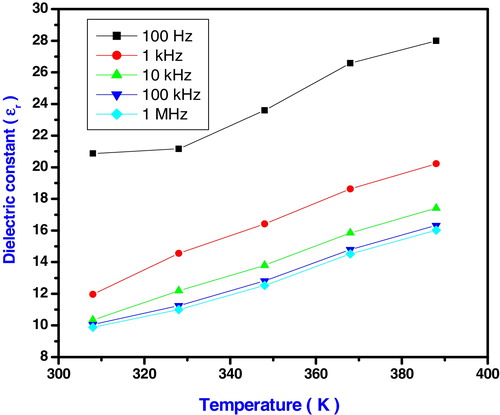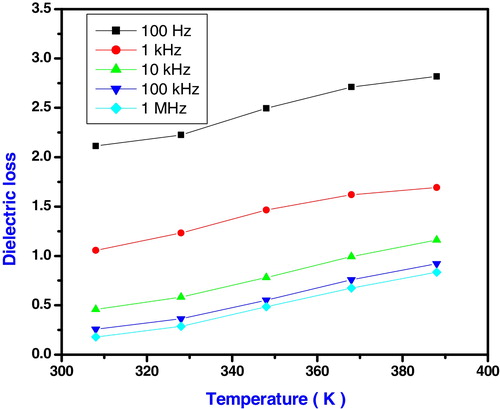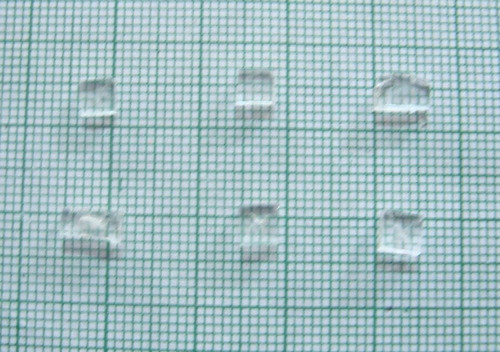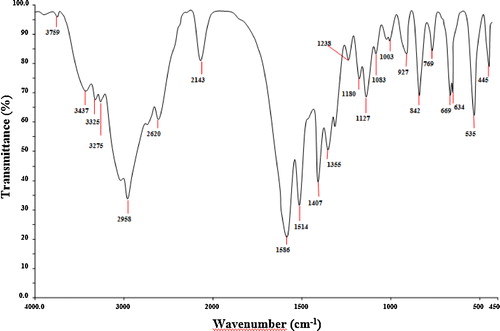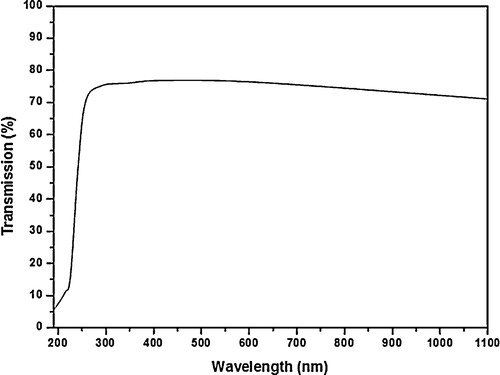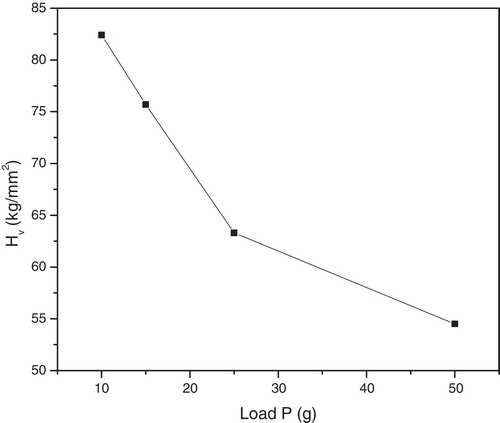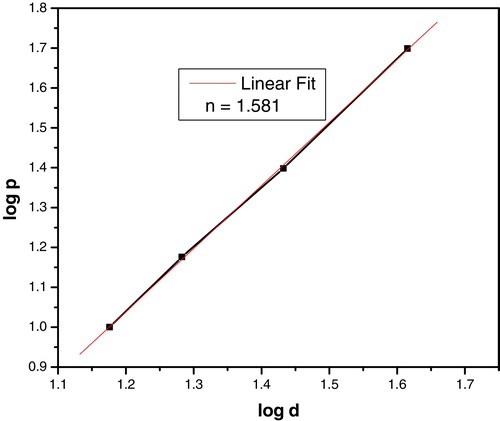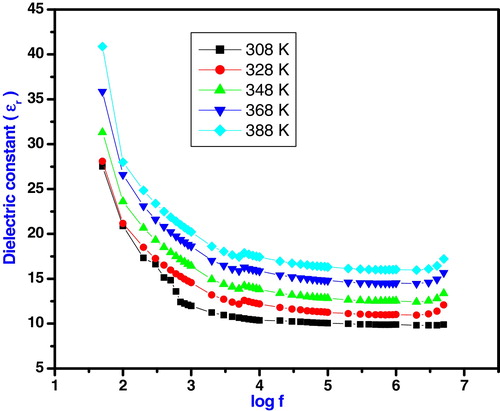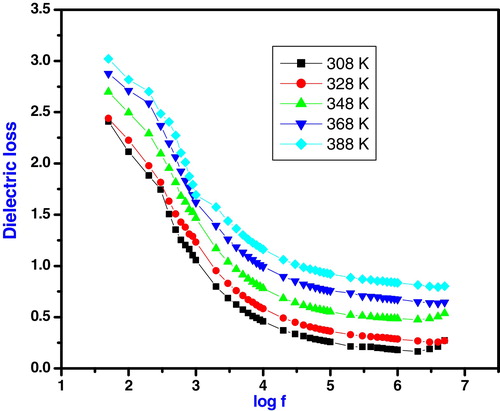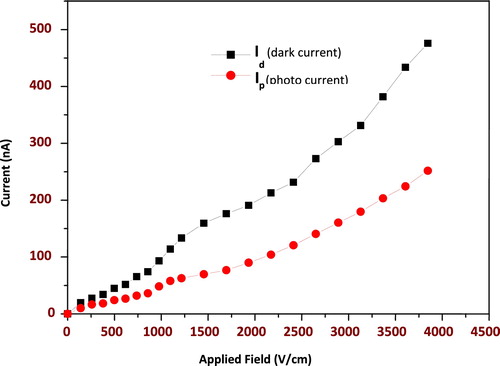 ?Mathematical formulae have been encoded as MathML and are displayed in this HTML version using MathJax in order to improve their display. Uncheck the box to turn MathJax off. This feature requires Javascript. Click on a formula to zoom.
?Mathematical formulae have been encoded as MathML and are displayed in this HTML version using MathJax in order to improve their display. Uncheck the box to turn MathJax off. This feature requires Javascript. Click on a formula to zoom.Abstract
An amino acid based semiorganic nonlinear optical family single crystal of l-leucinium perchlorate (LLPCl) was grown by the solvent evaporation method at ambient temperature. Good optical quality single crystals up to a size of 6 mm × 5 mm × 3 mm were obtained. The single-crystal XRD analysis shows that the grown crystals have a monoclinic structure. Fourier transform infrared (FTIR) spectral analysis and UV–vis spectral studies were also carried out. Microhardness mechanical studies show that the hardness number (Hv) of a LLPCl single crystal decreases with the load as measured by the Vickers microhardness method. The dielectric properties of the grown crystal were analysed by varying the frequency. Photoconductivity analysis gives the variation of the photocurrent and dark current. The nonlinear optical properties were studied using the Kurtz and Perry powder method and the second harmonic generation efficiency was found to be 2.6 times higher than that of KDP crystals.
1 Introduction
In the recent scenario of advanced technologies, nonlinear optical (NLO) materials have been shown to have wide applications such as second harmonic generation (SHG) optical modulation, electro-optic switches, optical logic, frequency shifting, colour displays and optical signal processing [Citation1–Citation5]. In general, organic materials have a conjugated system caused by nonlinear polarization that occurs because of the interaction of laser light with strong electromagnetic waves [Citation6–Citation8]. Due the technology requirements, increasing the nonlinear polarization of this molecule requires introducing an electron donor or electron acceptor group into the organic molecules [Citation9].
In this respect, amino acids are interesting materials for optical applications [Citation10,Citation11]. The tetrahedral array of four different groups about the α-carbon atom confers optical activity on an amino acid. The amino acids have a zwitterionic nature, which means they have a deprotonated carboxyl group and protonated amino group, which may provide an added improvement in nonlinear polarization [Citation11]. An organic amino acid mixed with inorganic materials is known as semiorganics, and this group of materials may play a major role in the NLO field [Citation12,Citation13].
In view of this, a series of crystalline salts of amino acids have been investigated, particularly the analogues of l-cystine, l-threonine, l-asparagine, l-arginine and l-leucine [Citation14–Citation18]. Among these materials, l-leucine is an interesting molecule from both the crystal engineering and supramolecular point of views. The l-leucine based semiorganic crystal has attracted much attention because it has a higher second-harmonic generation efficiency than potassium dihydrogen phosphate (KDP) [Citation19–Citation24]. l-Leucinium perchlorate (LLPCl) is a new material, first discovered by Jan Janczak and Genivaldo Julio Perpetuo, which is two times more nonlinear than KDP [Citation25]. Detailed vibrational, calorimetric and theoretical studies have also been performed [Citation26]. In the present investigations, the synthesis and bulk growth of l-leucinium perchlorate (LLPCl) crystals were studied for the first time. The grown LLPCL crystals have been analysed by single crystal X-ray diffraction (XRD), Fourier transform infrared (FTIR) spectroscopy, optical transmission, NLO, and thermal and mechanical studies.
2 Experimental
l-Leucine and perchloric acid were purchased from Loba Chemie at AR grade and used in an equimolar ratio. Double-distilled water was used to prepare the aqueous solution of LLPCl. The reaction that takes place between l-leucine and perchloric acid is as follows:
The perchloric acid is first dissolved in double-distilled water, and then the same molecular amount of l-leucine was slowly dissolved in the solution using a magnetic stirrer to prepare a saturated solution of LLPCl. After the solution was filtered using high-porosity filter paper, it was transferred into a new beaker, which was tightly closed with Teflon paper. Using the slow solvent evaporation method, a good-quality single crystal of LLPCl was obtained from the mother solution. Transparent colourless crystals with dimensions of 6 mm × 5 mm × 3 mm were harvested after a period of 40 days, and photographs of the as-grown crystals are shown in .
3 Characterization
The identity of the grown crystal of LLPCl was confirmed by single-crystal X-ray diffraction analysis. Single-crystal XRD data were collected by an ENRAF NONIUS CAD-4 single-crystal X-ray diffractometer with MoKα (λ = 0.71073 Å) radiation. The FT-IR spectrum was recorded over the range of 4000–450 cm−1 using a BRUKER IFS-66V spectrometer with the KBr technique. The optical transmittance was evaluated by a Shimadzu UV-2400 PC spectrophotometer in the range of 190–1100 nm. The NLO property of the LLPCl crystal was studied by the Kurtz and Perry powder technique using a Nd:YAG laser as a source. The mechanical property of the LLPCl crystal has been evaluated using Vickers microhardness studies. The dielectric constant and dielectric loss of the grown crystal were studied at various frequencies and temperatures using a HIOKI 3532-50 LCR HIESTER.
4 Results and discussion
4.1 Single-crystal XRD
The lattice parameters of the LLPCl were determined using 25 reflections collected through a random search routine with graphite-monochromated MoKα (λ = 0.71073 Å) radiation and indexed using the method of short vectors by least squares refinement employing the SHELXL programme. The single-crystal XRD data reveals that the LLPCl crystal has a monoclinic structure. The calculated lattice parameters are a = 5.68 Å, b = 8.762 Å, c = 10.707 Å and V = 532.87 Å3. From this analysis, the identity of the grown crystal has been confirmed by comparison of the presently calculated lattice parameters values with already reported values [Citation25], which shows close agreement.
4.2 FT-IR analysis
shows the FT-IR transmission spectrum of the LLPCl crystals. The grown powdered crystals were mixed with KBr, and the spectrum was recorded in the region of 4000–400 cm−1. The broad envelope between 3600 and 2200 cm−1 includes the absorption of stretching bands due to NH3+ ions and superimposed O–H and NH3+ stretching bands. It is noted that the bands at 3325 and 3275 cm−1 evidence the presence of weakly hydrogen bonded N–H groups. CH vibrations of the methyl group appear at 2958 cm−1, and the bands observed at 1514 and 1238 cm−1 are assigned to symmetrical and asymmetrical NH3+ bending, which reveals the protonation of amino groups. A C–O stretching vibration peak is seen at 1407 cm−1, and the peak at 1355 cm−1 is assigned to C–N stretching vibrations. The presence of –ClO4− is clearly evidenced by its characteristic peaks at 1122 cm−1 (asymmetric stretching) [Citation27], 929 cm−1 (symmetric stretching) and finally 634 cm−1 (asymmetric bending). The C–C stretching of CH–CO is reflected by the peak at 1180 cm−1, and the peak at 769 cm−1 is due to CH2 rocking vibrations. The CO2 double-degenerated mode of vibration is observed at 669 cm−1, and the COO– wagging vibration is observed as a sharp peak at 1632 cm−1. These vibrations demonstrate the existence of l-leucine in its salt form with perchloric acid.
4.3 UV–vis spectral analysis
The optical transmittance property gives important information on materials, particularly the optical transparency window, which is used in linear and nonlinear applications. The optical transmission spectrum for the grown crystal was recorded in the range of 190–1100 nm, and the obtained spectrum is shown in . The spectrum's characteristics can be attributed to the promotion of electrons in the σ-, π- and n-orbitals from the ground state to higher states. The spectrum reveals that the grown LLPCl crystal has a superior optical transmittance in the high visible area and shows no remarkable absorption in the visible region. This is an important property for nonlinear optical applications. The lower cutoff wavelength is as low as 245 nm due to the π–π* conversion in this crystalline material. The transmittance of the LLPCl crystals is approximately 75%. The transmission extends from 245 to 1100 nm, which suggests that these materials may be used in optical window applications.
4.4 NLO properties
The powder SHG efficiency of LLPCl was measured by the Kurtz and Perry powder technique [Citation28]. A Q-switched Nd:YAG laser beam of wavelength 1064 nm, input power of 10.8 mJ, and pulse width of 8 ns with a repetition rate of 10 Hz was used. The grown single crystal of LLPCl was powdered to a uniform particle size and packed in a microcapillary tube to expose it to the laser beams. The green emission from the sample was collected using monochromated light with an intensity of 532 nm. The same particle size of KDP was used as a reference material. The powder SHG signal reliably reflects the SHG action and can be associated with the noncentrosymmetric crystalline structure. It is found that the efficiency of the LLPCl crystal (138 mV) is 2.6 times greater than that of KDP (53 mV). The second harmonic generation conversion efficiency of the grown LLPCl crystal shows an aptness for frequency-doubling applications.
4.5 Microhardness study
Hardness refers to the resistance provided by a material that results in the confinement of the deformation caused by indentations to a small area. The plastic properties and strength of a material play a key role in device fabrication. The Vickers microhardness analysis has been measured using the well-polished plane of the crystal using a Vickers microhardness tester fitted with a diamond pyramidal indenter. The load of the indenter varies from 10 g to 50 g with a constant time of 10 s. The values of the Vickers hardness Hv at different loads were calculated using the expression Hv = 1.8544 (P/d2) kg/mm2, where P and d are the applied load and average diagonal length of the indentation, respectively. shows plots of the hardness number and applied load. From this graph, it can be observed that the hardness number decreases with the applied load, which is the normal indentation size effect (ISE). Onitsch reported that if the value of the work hardening coefficient n < 2, the microhardness number decreases with the increase of the load [Citation29]. The association of the load and size of the indentation is expressed by Meyer's law, P = kdn, where k and n are constants. shows the work hardening coefficient (n) value using a plot of log P vs. log d. From the slope, the work hardening value is estimated to be 1.581, which establishes the LLPCl crystal to be a hard material. Therefore, the mechanical strength of the grown single crystal can be exploited for device fabrication.
4.6 Dielectric study
Single crystals of LLPCl of the required size were selected for the dielectric measurements, with a thin coating of graphite applied on both sides to provide electrical conductivity. The capacitance of the crystal was noted at different temperatures using applied frequencies varying from 10 kHz to 20 MHz. shows the dielectric constant as a function of frequency varying with temperature. The dielectric constant initially decreases with the increasing frequency, and at low temperatures, the dielectric constant (ɛr) has a higher value. The magnitude of ɛr depends significantly on the degree of polarization and charge displacement of the grown crystal. The variation of the dielectric loss with the frequency () shows the same trend. The low dielectric loss shows that the grown crystal has few defects. and show that the values of the dielectric constant and dielectric loss simultaneously increase with the increasing temperature and decrease with the increasing frequency. The changes in the dielectric constant and dielectric loss as functions of frequency for LLPCl may be considered as a normal behaviour of dielectrics. These observations that the dielectric constant and dielectric loss are low at high frequencies indicate the presence of few defects in the LLPCl crystalline material, which is an important property for device applications [Citation30].
4.7 Photoconductivity study
Photoconductivity studies were conducted using a Keithley 485 pico-ammeter. For measuring the photo current, the input applied field is varied from 150 to 4000 V/cm using a halogen lamp of 100 W power by focusing the spot of light on the crystal using the convex lens. A graph of the dark current and photocurrent vs. the input applied field shown is . The value of the dark current is always higher than the photo current for all values of the applied field, so the LLPCl single crystal is found to exhibit negative photoconductivity.
5 Conclusions
A potential semiorganic material was synthesized from the amino family, and single crystals of l-leucinium perchlorate (LLPCl) were grown by slow solvent evaporation at room temperature. From single-crystal XRD, it was found that LLPCl crystallizes in a monoclinic system. All of the functional groups in the crystal were confirmed using FT-IR spectroscopic studies. The observed low-UV cut-off wavelength of 245 nm and the high transmittance in the visible region suggest the potential of this material in the field of NLO. From dielectric analysis, it is found that both the dielectric loss and dielectric constant decrease with the increase in frequency. At high frequency, the values of the dielectric loss and dielectric constant are low, suggesting that the grown LLPCl crystal has few defects. The Vickers microhardness values measured on LLPCl indicates the material's high mechanical strength. The SHG efficiency was measured using a Nd:YAG laser as a source, and its value was 2.6 times greater than that of KDP. Owing to all of these properties, LLPCl crystals could be promising members of the amino acid family for nonlinear optical applications involving the frequency doubling process.
Notes
Peer review under responsibility of Taibah University.
References
- X.J.LiuZ.Y.WangX.Q.WangG.H.ZhangS.X.XuA.D.DuanS.J.ZhangZ.H.SunD.XuMorphology and physical properties of l-arginine trifluoroacetate crystalsCryst. Growth Des.8200822702274
- J.BadanR.HierleA.PerigaudJ.ZyssD.J.WilliamsNLO properties of organic molecules and polymeric materialsAmerican Chemical Symposium Seriesvol. 2331993American Chemical SocietyWashington, DC
- N.ZaitsevaL.CarmanRapid growth of KDP-type crystalsProg. Cryst. Growth Charact.4320011118
- H.S.NalwaH.S.MiyataNon-linear Optics of Organic Molecules and Polymers1997CRC PressBoca Raton, FL
- P.N.PrasadD.J.WilliamsIntroduction to Nonlinear Optical Effects in Organic Molecules and Polymers1991Wiley InterscienceNew York
- D.S.ChemlaJ.ZyssNon-linear Optical Properties of Organic Molecules and Crystals1987Academic PressOrlando, New York
- N.J.LongOrganometallic compounds for nonlinear optics—the search for enlightenmentAngew. Chem. Int. Ed. Engl.3419952138
- T.VerbiestS.HoubrechtsM.KauranenK.ClaysA.PersoonsSecond-order nonlinear optical materials: recent advances in chromophore designJ. Mater. Chem.7199721752189
- D.XueS.ZhangChemical bond analysis of the correlation between crystal structure and nonlinear optical properties of complex crystalsPhysica B26219997883
- L.MisogutiA.T.VarelaF.D.NunesV.S.BagnatoF.E.A.MeloJ.M.FilhoS.C.ZilioOptical properties of l-alanine organic crystalsOpt. Mater.61996147152
- M.FleckM.AramPetrosyan, Salts of Amino Acids, Crystallization, Structure and Properties2014Springer International PublishingSwitzerland
- R.Mohan KumarD.Rajan BabuD.JayaramanR.JayavelK.KitamuraStudies on the growth aspects of semi-organic l-alanine acetate: a promising NLO crystalJ. Cryst. Growth2752005e1935e1939
- M.Esthaku PeterP.RamasamyGrowth, thermal, dielectric and mechanical studies of triglycine zinc chloride, a semiorganic nonlinear optical materialMater. Lett.64201013
- D.EimerlS.VelskoL.DavisF.WangG.LoiaconaG.KennedyDeuterated l-arginine phosphate: a new efficient nonlinear crystalIEEE J. Quant. Electron.QE-251989179193
- J.J.RodriguesJr.L.MisogutiF.D.NunesC.R.MendoncaS.C.ZilioOptical properties of l-threonine crystalsOpt. Mater.222003235240
- M.ShakirB.RiscobK.K.MauryaV.GaneshM.A.WahabG.BhagavannarayanaUnidirectional growth of l-asparagine monohydrate single crystal: first time observation of NLO nature and other studies of crystalline perfection, optical, mechanical and dielectric propertiesJ. Cryst. Growth312201031713177
- S.AdhikariT.KarBulk single crystal growth and characterization of l-leucine – a nonlinear optical materialMater. Chem. Phys.133201210551059
- K.SelvarajuR.ValluvanK.KirubavathiS.Kumararamanl-Cystine hydrochloride: a novel semi-organic nonlinear optical material for optical devicesOpt. Commun.2692007230234
- S.GuidaraH.FekiY.AbidVibrational spectral studies and non-linear optical properties of l-leucine l-leucinium picrate: a density functional theory approachSpectrochim. ActaA1152013437444
- G.BhagavannarayanaB.RiscobM.ShakirGrowth and characterization of l-leucine l-leucinium picrate single crystal: a new nonlinear optical materialMater. Chem. Phys.12620122023
- S.AdhikariT.KarExperimental and theoretical characterization of semiorganic nonlinear optical material l-leucine hydrobromideMater. Res. Bull.48201316121617
- S.AdhikariT.KarExperimental and theoretical studies on physicochemical properties of l-leucine nitrate – a probable nonlinear optical materialJ. Cryst. Growth356201249
- P.BaskaranS.RajasekarM.KumarM.VimalanK.SelvarajuThermal and electrical behavior of organic nonlinear optical single crystals: l-leucinium oxalate (LLO)Arch. Appl. Sci. Res.620149098
- M.AnbuchezhiyanS.PonnusamyC.MuthamizhachelvanGrowth, spectroscopic, optical, mechanical and thermal studies of ß-alanine cadmium chloride crystal, a semi-organic nonlinear optical materialOptoelectron. Adv. Mater.3200911611167
- J.JanczakG.J.Perpetuol-Leucinium perchlorateActa Cryst.C632007o117o119
- M.K.MarchewkaM.Drozdl-Leucinium perchlorate: new molecular complex with nonlinear optical properties. Vibrational, calorimetric and theoretical studiesCent. Eur. J. Chem.11201312641277
- T.MallikT.KarOptical, thermal and structural characterization of an NLO crystal, l-arginine perchlorateJ. Cryst. Growth2742005251255
- S.K.KurtzT.T.PerryA powder technique for the evaluation of nonlinear optical materialsJ. Appl. Phys.39196837983813
- E.M.OnitschUber die Mikroharte der MetalleMikroskopie21947131151
- G.P.SmythDielectric Behavior and Structure1955McGraw-HillNew York


